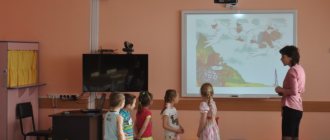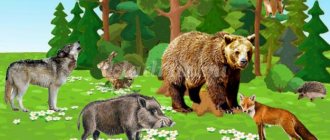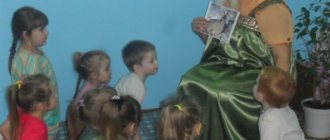Summary of educational activities on speech development “Spring has come” for children of the middle group
Summary of OD in the middle group of kindergarten "Spring"
Topic: "Spring has come." Use of technology: person-oriented, health-saving. Objectives: - consolidate children’s knowledge about the season “spring”; names of the spring months; features of trees and shrubs; animal life in spring; - teach to notice and express impressions about the beauty of spring phenomena; — to instill in children an interest and respect for nature. Objectives: Educational: to consolidate ideas about the seasons, natural phenomena, changes in the lives of animals.
Developmental: increase motor activity, enrich gaming experience. Educational: to instill in children an interest and respect for nature. Materials: pictures with the phenomena of spring, with winter and spring clothes, weather, forest animals and their delicacies; bear toy, model of a tree, tape recorder, Preliminary work: observing the weather during a walk, reading stories: “Spring Joys”, “Birds”, “Stream” (N. Sladkov); “Under the bush” (N. Pavlova). Solving riddles about spring. Progress OD:
Educator: - Hello, guys! Today we will have a very interesting lesson, but first you will guess my riddle: Loose snow melts in the sun, The breeze plays in the branches, The birds’ voices are louder. So, it has come to us... (SPRING) Educator: - That’s right, spring! (A. Vivaldi’s composition “The Seasons” Spring is included). - Guys, listen to this beautiful melody, do you think it’s funny or sad? (cheerful). That's right, well done, cheerful. This melody is about spring coming! Educator: - How do we know that spring is coming? I'll tell you with my riddles. The teacher makes riddles and shows pictures with the phenomena of spring: It has warmed up a little - The very first, the bravest, A small forest one looked out of a snowy fur coat... (Snowdrop)
It rings outside the window, And sings: “Spring has come!” And turned cold icicles into these streams!” You can hear from the roof: “Slap-slap-slap!” It's a small flood. (Drops)
The snow has melted and a nimble one is running from the fields... (Stream.)
They grow on branches. For the winter they will all fall asleep. In the spring, the leaves will swell and appear from... (buds).
Educator: - Well done, smart kids! How is spring different from other seasons? For example from winter. (children's answers) Let's compare winter and spring and play the game “Say the other way around”: In winter, the snow is white, and in spring (gray); In winter the snow is clean, and in spring (dirty); In winter the days are cold, and in the spring (warm); In winter the days are short, and in spring (long); In winter the sun is dim, and in spring (bright); In winter the sky is gray, and in spring (blue); In winter the wind is cold, and in spring (warm); In winter the sun is low, and in spring (high); It got colder in winter, and warmer in spring. Educator: - I will now show you pictures, and you will tell me what time of year this picture is suitable for. (pictures with winter and spring clothes, weather, natural phenomena.) The teacher shows the pictures, and the children take turns going out, choosing what time of year this picture is suitable for and putting it in the right direction.
Educator - You are great! Do you know the spring months? How many months does spring have? Let's name them! (March April May). That's right, well done! Tired of sitting? Let's warm up and have a physical minute: Physical minute. The bear crawled out of the den and looked around at the threshold. (turns left and right) He stretched from sleep (stretching his arms up) Spring has come to us again. To quickly gain strength, the bear twisted its head. (rotates his head) Bent back and forth, (leans back and forth) Here he is walking through the forest. The bear is looking for roots and rotten stumps. They contain edible larvae - vitamin for the bear. (tilts: touch your left foot with your right hand, then vice versa) Finally, the bear had eaten and sat down on a log. (Children sit down) A tree appears, under which a bear toy sits, and the “Sounds of the Forest” melody plays. Educator: - Guys, look, we seem to be in the forest, but who is hiding under the tree? (the teacher picks up the toy and listens to it). This is a bear cub and he says his name is Mikhail. He is very interested, do the guys know how animals greet spring? (children's answers) Educator : - That's right, guys, animals awaken from hibernation, change their coats, and have cubs. Well done! Just remember that the forest is a home for birds and animals, and we are guests in it, so you need to behave well so as not to scare the inhabitants of the forest. Educator : — (listens to the bear cub), Guys, Misha wants to play with you. On the board on top are cards with animals (bear, hedgehog, hare, squirrel, fox), and below are cards with food (berries, mushrooms, tree bark, fish, nuts, banana). Educator : - Look at the pictures, Misha wants you to give each animal the delicacy that he loves. Who wants to play? (children place cards according to the assignment), Well done, tell me which treat is extra? (banana). That's right, Mishutka wanted to confuse you, but you did it! Let's stretch our fingers and show the little bear how we can do finger gymnastics! Finger gymnastics: “A squirrel is sitting on a cart.” A squirrel sits on a cart and sells nuts. (clapping palms and hitting each other with fists alternately) To the little fox-sister, bend one finger at a time, starting with the big Sparrow. Titmouse, Teddy Bear, Mustachioed Bunny. To whom in a scarf, (Rhythmic clapping of palms and blows with fists) To whom in the goiter, To whom in the sweetie. Educator: - Well done, guys. Mishutka really liked it and said that he would teach his friend the squirrel to do such gymnastics. He also asks us to come up with a story about him. Let's try? (yes) Educator: - Where does the bear live? (in the forest), Is the bear big or small? (big), What color is his fur coat? (brown), What kind of eyes does he have? (black, round), What kind of paws does he have? (large) What does he eat? (nuts, berries, mushrooms, fish), What does he do in winter? (sleeping). Educator : - Well done, guys! We have an interesting story about a bear. Please listen to what we got: A bear lives in the forest. He is big, with big paws and small black and round eyes. The bear's coat is brown. It feeds on nuts, mushrooms, berries and fish. In winter he sleeps, and in spring he awakens. Children tell the story in a chain. Educator: — (listens to the bear cub), Guys, Bear really liked our story! He says thank you very much to all of you, but it’s time for him to go home. Let's say goodbye to Mishka. (children say goodbye). And it’s time for us guys to join the group. Let's close our eyes and open them. (The music of A. Vivaldi “The Seasons” Spring is turned on). Educator: - So we returned to the group. Guys, where were we? (children's answers), who did we meet? What time of year did we remember? Did you like the lesson? (Yes).
We recommend watching:
Spring fun in kindergarten. Middle group Summary of GCD on speech development in the middle group on the topic: Spring GCD in the middle group of kindergarten on the topic: Spring. Cognitive development Summary of GCD for the middle group of kindergarten on the topic: Spring
Similar articles:
Summary of the lesson “Wild animals in spring” in the middle group
Entertainment dramatization on the theme: Spring in kindergarten. Middle - senior group. Scenario
Spring games for middle group children in kindergarten
Drama about spring for preschoolers
Summary of a spring walk in the middle group





